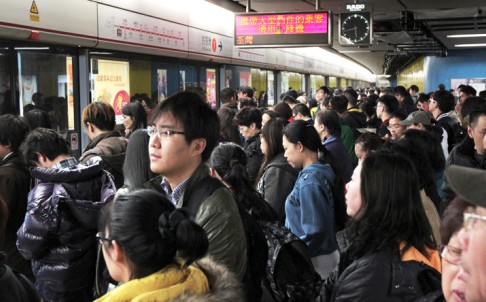Seriously i have not taken the SMRT for a long time so after watching Hong Kong's MTR during peak hours, let me know your comparisons and opinions, cheers.

100 million tourists by 2023 prediction sparks fears the MTR will not cope
Annual tourist arrivals may hit 100 million in a decade, the government says. Can the city really take so many visitors? In the first of a series of reports, we ask: is the MTR pushing capacity?
PUBLISHED : Friday, 24 January, 2014, 3:40am
UPDATED : Friday, 24 January, 2014, 6:48pm
Stuart Lau and Ada Lee

People wait at Admiralty station at rush hour. Photo: Thomas Yau
It can be a worker's hardest job of the day - squeezing into an MTR train during peak hours.
Some see four full trains go by before finally being able to struggle onto the fifth one at Admiralty station, while as many as 1,000 other people continue to line the platform, hoping for better luck with the next train.

Harassed commuters are asking whether the city's railway system will be able to cope with the government's estimate of 100 million tourists in 2023, as stated last week by Secretary for Commerce and Economic Development Greg So Kam-leung.
Experts also expressed doubts, with one saying the city's tourism planning could be among the worst in the world.
"The long queues have been around for so many years without much improvement. It would be magic if you could get on the train easily at 6.30pm," said Raven Wong Kar-yin, 40, an insurance worker waiting for a Tsuen Wan-bound train at Admiralty at that time last Thursday.
Observations showed that on a normal weekday evening, an average of 20 to 50 people queued outside each of the doors on Tsuen Wan-bound trains at Admiralty station, one of the most heavily used routes for cross-harbour commuters, between 6pm and 7pm.
That works out to more than 1,000 people at a time waiting for each of the trains that come every 106 seconds or so at one of the busiest interchange stations.
Watch: Hong Kong's MTR during peak hours<object classid="clsid

<embed src="https://static.movideo.com/flash/movideo_player.swf" quality="high" bgcolor="#000000" name="player-element" play="true" loop="false" allowscriptaccess="always" allowfullscreen="true" type="application/x-shockwave-flash" wmode="window" pluginspage="http://www.adobe.com/go/getflashplayer" flashvars="apiKey=movideoScmp&alias=SCMPflash&playerId=movideoScmp_SCMPflash_1390685238434&mediaId=703457" align="middle" width="512" height="288"></object>
An MTR official with knowledge of the Island Line's operation said the situation at Admiralty was "under control", adding that queues were up to twice as long before station improvement work. But he admitted there had been an "obvious increase" in passengers in recent years.
An analysis by the South China Morning Post found that half of the 54.3 million arrivals to the city came through the two railway control points - Lo Wu and Lok Ma Chau, which link directly to the East Rail Line. Should half of the 45.7 million new visitors do likewise, the East Rail Line would need some 17 additional trains a day in 2023 if the current occupancy rate is to be maintained.
The line's loading at peak hours reached 70 per cent in 2012, with average daily passenger flow up by 14.6 per cent to 1 million compared with 892,000 in 2008. Occupancy on the Island line was also about 70 per cent.
Passenger Lucy Lee said she did not think the MTR could cope with more tourists, although she said she saw "not too many tourists" at peak hours.
That might not be true. As Lee was waiting for her third train, dozens of Asian tourists, including mainlanders, were seen dragging luggage, flipping through maps and holding cameras.
Veteran transport analyst Dr Hung Wing-tat said the 70 per cent occupancy rate could mean some stations were close to or had already exceeded their capacities, as some stations were less crowded than others.
The cross-border express railway is due to open next year and more railway lines, such as the North Island Line, are being planned. Hung said they might help relieve the situation.
The MTR expects 23 per cent of south-bound East Rail passengers to switch to the Sha Tin-Central link when its first phase, between Tai Wai and Hung Hom, opens in 2018.
Professor Bob McKercher, at the Polytechnic University's school of hotel and tourism management, said Hong Kong had long ignored planning for same-day-return visitors, who put more pressure on the transport system than overnight travellers. In the first 11 months of last year, 25.9 million of 49 million visitors did not stay the night.
"Hong Kong plans its major infrastructure well, but it could have the worst-planned tourism," McKercher said.
Most day visitors would go to the shopping malls and "behave very differently from overnight tourists", he said, adding that shopping malls for them should be built near the border so they did not increase the burden on the transport system.
Last edited:

